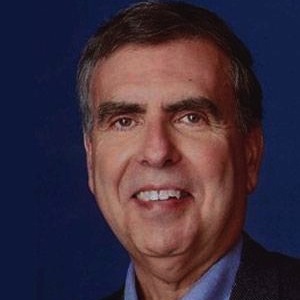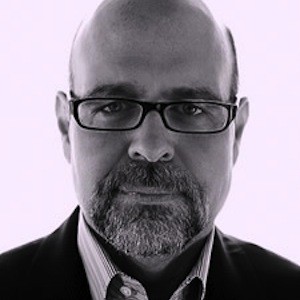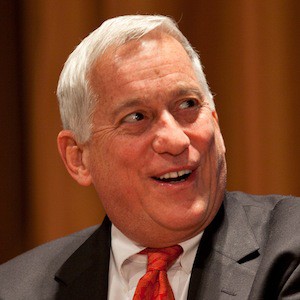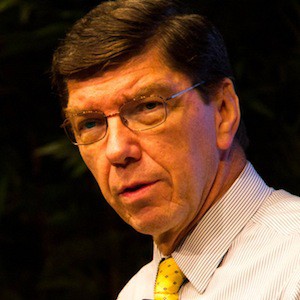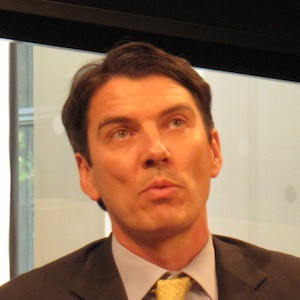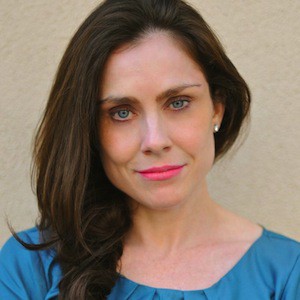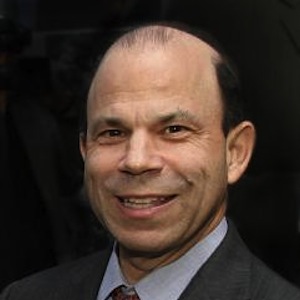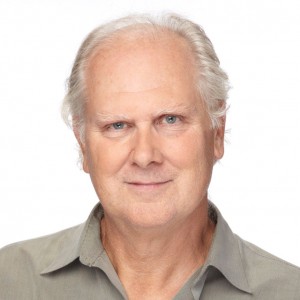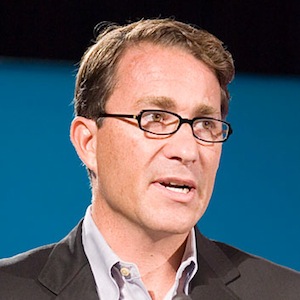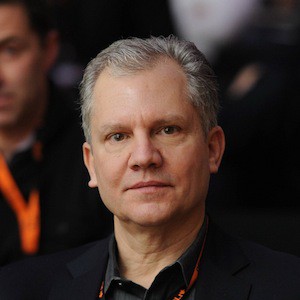John Huey: It’s February 20th, 2013 in Cambridge, Massachusetts at the Harvard Kennedy School’s Shorenstein Center. Paul Sagan, Martin Nisenholtz and John Huey are having a conversation with Jerry Levin about the long, fascinating history of the intersection of digital technology and media, specifically journalism. Jerry, obviously you will have an opportunity to go back and start at any point you want but for sake of getting the conversation going, you mentioned something to me the other day about a moment you had when you were at HBO where you looked at a screen and it had to do with slow scan television. You suggested that that might have been the beginning of something that got you going in a direction digitally. Is that…?
Jerry Levin: Actually, before we started HBO, I was in…It was Sterling Manhattan Cable in a little office working on the business plan. Next to my chair was an AP news wire with a camera in front of it. In the cable system at that time, that’s how news was delivered to the audience. What fascinated me was I was more interested in reading what was coming off the wire. I thought this was fantastic because somebody at home can get the news just as quickly as any reporter working for any company.
That was a pivotal thing for me. I didn’t think it was primitive that there was a camera set up in front of a news wire.
After we started HBO, I kept thinking about ways of delivering news into the home. A lot of being even a small part of Time Inc. at the time, because I was taken by Life Magazine and pictures. I asked one of the engineers at Manhattan Cable, “Is there a way you can get a news wire into the home? Let’s get pictures into the home because…To see Life, to see the world.” What Harry Luce said about Life.
I said, “Oh, we’re great. We have this technology called slow…” This is more than you’d ever need to know.
John: No, no. This…
Jerry: Slow scan technology. A photograph will wipe across the screen. Now, it takes a little time and people may get a little impatient but you can deliver a picture. We set it up in our office there and did a little model. I thought, “Well, it’s probably going to be too difficult for people but at least they gave me the notion that…” This is all analog technology at the time. You could deliver text and you could deliver pictures.
John: Do you recall what year this was?
Jerry: It probably was well before CNN because I used that slow scan pilot to suggest to Time Inc. that we do a video pilot, to start a news service. So that would have been before HBO went profitable. So probably HBO turned the corner in 1977. It was somewhere around there, ’76, ’77. Those who had the purse strings at Time Inc. said, “No. Until you turn the corner at HBO we’re not going to start this other thing. Because we’re Time Magazine and SI and Fortune. We just started People. Life is going to close at that point.” I said, “OK.” That’s when Ted came by and said…We actually used…I forget his name. We did a pilot. It was the same person that Ted hired first for CNN. I said, “You should go ahead and do it.”
John: Reese Schonfeld?
Jerry: It was Reese Schonfeld first did a pilot for us. Yes, thank you. So that was an abiding interest in journalism. The other thing that…Shall I continue?
John: Yes.
Jerry: That struck me at the time. Even though we were starting an entertainment service we were very active with the Hughes Aircraft people. Because Jim Shepley was a conquistador and he originally wanted HBO to be a part of Hughes.
Martin Nisenholtz: They were in the satellite business?
Jerry: Yes. It was all satellites. It was going to be a four satellite service, four channels. I talked to one of the engineers. We had lunch. It was guy named Paul [inaudible 05:42] . He said something to me. He said, “The technology…I don’t know when it’s going to happen. But you’re going to be able to duplicate the Library at Alexandria. Anybody who wants to get any information will be able to get it.” I went, “Wow.”
John: He was painting a vision of a technology…
Jerry: Without specifying a technology.
John: Without knowing what it was but he had a vision that someday, technology would be able to capture all knowledge, all printed material, everything would be somewhere. That got you thinking what?
Jerry: We need to do one other thing. Even though we were starting HBO, the concept of HBO, as primitive as it was if they made the [inaudible 07:42] was to give the consumer, or the reader, three Cs. Choice, convenience and control. So that I can reach in and get anything I want at any time that’s on my time. So for HBO, very primitively, repeated programs. So that people could watch it. It was a revolving carousel.
John: That’s a thing that we’re going to revisit again and again. With full service network, with digital.
Jerry: Exactly. But it’s origins were in the business plan of HBO. I’m not saying it was obvious, but it was certainly in my head. Plus the technology, as primitive as it was, what we were trying to do we were always going to be frustrated. Because you couldn’t deliver, “I can get what I want immediately.” It was still a pushing technology. We weren’t alone. Qube, the idea of interactive television.
John: That’s in Columbus, Ohio?
Jerry: Qube was in Columbus. It was Warner’s…One of the reasons we were interested in Warner’s in the mid to late seventies. But in the beginning of the seventies, when I first started HBO in Orlando, somebody tried to put two way…Not transformers. But along the poles themselves, amplifiers. It was the first place where there were two way amplifiers. My whole introduction to journalism and technology was all about two way. There was no talk of digital at the time, no Internet, no computers. It was taking all these pieces and seeing how you can get interactivity. That was the goal. From Qube we went, tried to do things in Queens, in any event. TeleText was part of this drive.
I don’t know how I was able to get authorization. I was running the video group at the time, to build a studio that would deliver journalism that was theoretically two way, but was actually one way, and was called TeleText. We got Don Sider, (Dick) Stolley was involved. We got a number of journalists involved. We created a TeleText newsroom.
It was to be delivered to Orlando by satellite, into something that wasn’t a cable converter box. It was a box that would take the text and put it on…Now, you could access it, because it was streaming down. It wasn’t technically two way, but to the consumer, it might feel like it was two way.
I thought, this is great, because we can test how much information can the consumer handle, what kind of journalism, what kind of information is…The most interesting finding was that we couldn’t deliver this is my recollection enough information fast enough, deep enough, to satisfy the consumer’s appetite.
Rather than being, hey, we’re onto something with this technology, it suggested that if ever you could find a technology that had much greater capacity that was truly two way, the consumer would be there.
Martin: At the time did you see teletex as a potential threat to print, or was that not even in the back of your mind?
Jerry: That’s a good question. No, because I thought that the style of print, and not anticipating iPads and other things, but would always have its place. But this is now an additional way of having the consumer get direct access to news feeds and make judgments, but there’ll always be a need for editorial discussion and analysis on top of that. Now whether print is going to survive is not anything I thought about in those days, but it was always supplementary, and the concept was let the consumer have access to the same feed, and then go to whatever other sources the consumer wants to go to.
Martin: Now the TeleText service was in…around 1980 or ’81.
Jerry: Yes.
Martin: By that time the PC had been invented. Apple was out there, Tandy. IBM brought its PC out in ’81. And there were nascent services for the PC. CompuServe is the one that comes to mind. You must have looked at that. Why bet…was the bet on the TV cable implementation vs. the PC just a practical one because these devices were in the home and you thought you could get these decoders in? Because you weren’t at that time betting on the PC.
Jerry: No, PC hadn’t proliferated. What we were betting on was the power of the network, that if you had an almost infinite capacity network, satellite and cable, you could deliver a stream of information, and the handset or the set top box didn’t matter as much as using the network. I was very network oriented at the time. There wasn’t a uniform PC. It was very slow and primitive. I wanted the speed in the network, which is the way we would think as a cable operator.
John: So were you at the time thinking of set top box technology that would advance that technology?
Jerry: Yeah.
John: You were working with those people?
Jerry: Yeah.
John: Scientific Atlanta?
Jerry: But it was more a consumer test. It was more can you take a journalist…and you’re not writing for print. You’re writing for a daily stream. And so, what does that mean? What do you provide? How do you give access to the consumer of something they’ve never had before? I mean they could hear the news. They could watch a newscast. It was to see if we could take journalists that’s why I keep mentioning Stolley, because I was interested to see how Stolley would react. Don Sider was very good technically, but can you take a traditional print journalist and put them in a TeleText newsroom that’s not a print newsroom? You’re not closing an issue with printing technology. And so, I found that there was great interest on the part of the journalists.
John: Stolley was running that newsroom at the time?
Jerry: He was involved. Don Sider was the manager, because Stolley was doing other things, but he was definitely involved.
Paul: There were several media companies that tried some versions of TeleTexting that period or trying to deliver things online, and that chapter closed unsuccessfully for the industry, I think. Was there a conclusion? Was there a group lesson? One of the things that has been suggested to us is that that’s where print got way ahead and felt its hands got burned and maybe backed off and missed the next wave of…
Martin: Yeah, and VideoText, actually, the Times Mirror, Gateway, the Viewtron, all that stuff was happening at the same time.
Paul: Do you think they were related completely or parallel? What do you think was going on in that period?
Jerry: It possibly [coughs] means that print felt pretty good, that these technologies were either so inefficient or so far in the future that we didn’t need to worry about them or adapt to them. And that infused, I think, the print culture. So these were all failures. TeleText was considered a failure, and I don’t know why the $25 million number sticks in my head, but it was a costly thing.
Paul: That was real money back then.
Jerry: Yeah. It was costly. I’m amazed that I had the authorization to do it, but the video group was the darling of Time, Inc. at the time, and there was a lot of interest, but then we basically shut it down. So when you shut something down at Time, Inc., it’s a failure. It’s not a success.
Paul: The next thing that really happened was cable news in a sequence, right? Before online, CNN came along.
Jerry: Yeah, CNN came along in 1980.
John: And you were on the board of Turner at that time, right?
Jerry: Yeah.
John: Do you recall any transition from…you’d been dealing with the news on the print side, then the TeleText, now all news.
Jerry: But also I wanted to start some video news service, which wasn’t ultimately realized until New York One, until we ultimately bought CNN. And so, we had a pilot that Reese Schonfeld did, and I could not sell it to Time, Inc. Ted came by and said, “I heard you’re working on something. I’m going to go ahead and do this. I said, “Go ahead and do it, because we’re not going to do it, and Godspeed, because we’ll support it.”
Martin: One of the things, one of the themes that seems to be true throughout this whole period and well into the ’90s and beyond, is that large corporations, maybe because of their culture, maybe because of the point you made that it wasn’t a threat, just don’t seem to be able to adapt as quickly to some of the digital technologies as the entrepreneurial community that operates on a, in a funny way, slower but faster cycle. At the same time as you’re shutting TeleText and Knight Ridder is shutting down VideoText, and Times Mirror is shutting down its VideoText service, Steve Case is starting up AOL or not Steve, but the quantum computing guys in the mid nineties. That must have seemed trivial at the time.
Jerry: Well, it was always an issue. Well, first of all, there is an issue. A large corporation, which makes most of its money and therefore its Wall Street stock success is based on its inbred businesses. The threats seem unavailing because you’re walled up in your own secure revenue generation, but it was at least clear that we wanted to start something. Pathfinder was our way of starting a service using these computers. The Full Service Network was definitely…in Queens we had tried to start an interactive two way service. The Full Service Network was designed to demonstrate that with a network and writing the right code with Silicon Graphics that you can give people the ability off of the screen, the television screen, to pick anything you want, stop it, start it, go backward, forward news, movies, whatever.
Paul: Games and commerce.
Jerry: And games and commerce. It pretty much had everything. Now what’s interesting about it is it was considered a failure, and a lot of money was spent, and yet all of the code that was written…It was the first server that delivered digital on demand service, and the code for interactive everything really came from that system. It was a failure because it was too much too early. We knew the consumer was there, but we couldn’t spread it across enough of the subscribers to make a difference.
Martin: On the journalism side, though it seems to me I was struck by one of the things you said about TeleText was you really couldn’t deliver as much as the audience wanted. The same thing happened in Orlando because we could only cut up a certain amount of existing TVD.
Jerry: Yeah, we were limited.
Martin: Yeah, and so they consumed it, and there just wasn’t much more yet, right? It was…
Jerry: It was the same finding.
Martin: Yeah, same finding.
Jerry: Because even though it was advanced technology…it’s a very good point what the consumer wants everything. We’re back to that library at Alexandria. I want to be able…we’re now there, but I want to be able to get anything I want at any time immediately.
John: But I think the seeds…
Jerry: Unpredictable…
Paul: …of the issue to me go back to this point of use of the network. So to your point, a content company would look at delivering content to a user. I think what the early PC networks found particularly AOL was that user/user communication was really almost an to use your point about limits unlimited thing. I could email you back and forth all day or chat. So this notion of communication versus content I think is an interesting one.
Jerry: No, that’s a great point, and not to bring up a lot of conflicting history, but when we were combining with AOL, and I was asked the question what I thought the most interesting feature of AOL was, I said, “instant messaging,” that the ability for people to communicate back and forth probably was a goldmine of opportunity on an unlimited basis. It is true that you needed the communications, but in all cases what you needed was the network. You needed the broadband capability so that any box, any instrument, didn’t have to be so smart. You didn’t have to download everything in the world, that it was all in the network. And now it’s in the cloud.
John: So we…
Martin: We need go back…
John: Yeah, I was going to back up to Pathfinder.
Martin: Well, even before that, because…
John: Oh, good. Yeah, you mentioned a lot of things we need to go back and fill in.
Martin: If we talk about journalism as opposed to just interactivity or communications or those things, there wasn’t much new journalism yet. So the dialup era, which was CompuServe, Prodigy, and AOL, was about re purposing old stuff in much the way Orlando was the about slicing and dicing. So maybe it would really be worth talking about, because Time, Inc. this was just when I entered the picture there was pretty active in putting existing stuff in a new distribution channel, but not creating new journalism.
Jerry: And none of the systems…There was a eureka phenomenon that, gee, if we can take stuff that already exists and put it in a different platform, that’s a double use of the same material. The adjacent argument is that there isn’t a sufficient revenue stream coming from these new distributions to fund original material. Now one of the things we thought was, well, but what it can enable you to do is you never have to close a piece of journalism, that instead of having an edit point, close the issue. Put it out there you’ve already written it and then have the comments come in and keep the flow going. Thought that was an interesting way.
This is a characterization, but I think we had to find only a certain type of journalist who was really interested and engaged in trying this. Now we definitely tried this from…First of all, we wanted all the Time, Inc. journalists to have video cameras, and that was an aspiration that never quite happened, to get away from pencil and pad.
John: And that would have been roughly in 19, what?
Jerry: 81.
Martin: 80, the early eighties?
Paul: No, no.
Jerry: No, no, early nineties.
John: Early nineties.
Jerry: Early nineties. We actually under…Joe Quinlan , whoever else was involved, we undertook a little program. Anybody who wanted to you could come, and we’ll teach…here New York One journalists are carrying a camera around and doing stories. Why can’t you, if you’re going to interview somebody, use that? This is my impression. It was a slow pickup on that, because you can’t take a print journalist and just move them over here.
John: Well, this is going to a recurring theme for the whole 40 years is that print journalists were clearly the cows that didn’t want to go in the chute. They just wanted to stay in the pasture they were in. There’s no question about it. It may even be true.
Jerry: Less so.
John: Well, there are fewer of them. So how does this…we’re going to talk to Walter (Isaacson). We’re going to talk to Paul. We’re going to talk to a lot of people about Pathfinder, but what’s your memory of that in the evolution?
Jerry: It was a stepchild, but what it indicated to me was that there were certain people who were really interested. Walter. Walter was one of the first people who came to me and talked about the World Wide Web so he was already into it. Paul and everybody was doing it at New York One. There was a group that really wanted Pathfinder that we’re Time, Inc. We should be number one because we’ve got the number one content.
John: Now at the time you were talking about these videos, you were talking about them being re purposed for New York One, or…?
Paul: And CNN and anywhere we could place them.
John: Anywhere else. OK.
Jerry: Yes. Right.
Paul: We put some on PBS.
Jerry: Right.
Paul: Anyone with TV at that…not online.
John: OK, so that’s separate from Path…
Paul: You couldn’t do video online.
John: There were no…because it was dialup.
Jerry: But Walter was very important, because it was not only Pathfinder, it was…you know, he was really the lead component for the full service network, the idea that we’re going to deliver on demand news, video on demand news. Now, again, you can see how we were trying to be utilitarian, because we had New York One, so we’re already producing. We’re trying to get some of the journalists to carry a camera around so it was to take some existing stuff and put it down here. We were a little taken by the technology, that, boy, I can start, stop, call up video.
Now at the time we called it VCR functionality because that’s what people did with videocassettes, but, boy, that there was no videocassette, and you could do that on your television set, just with the remote. So I think we were so intrigued by that technology that why isn’t that enough? But, of course, it wasn’t enough. What the consumer was saying is, “Hey, we’re getting prepackaged stale news here instead of robust new material.”
Paul: So we gave them the convenience, not the choice yet.
Jerry: I think that’s right. And it shows you how hard it is to bring all these disparate technology elements together with the content when you’re talking people away from their existing…you’re taking the consumer away from their existing experience, and you’re taking the journalists away from their existing form of communication and trying to marry them. It’s a little frustrating. It just takes a little longer.
John: Can you remember, if you put yourself back into time, what else was going on around you that you were interested in that other technology…This was about the same time that the Bell Atlantic thing came up. I assume that’s going to be a network story. But in terms of journalism and content, what else were you looking at? You always were absorbing the competitive landscape.
Jerry: We had looked at all the things, all the companies that tried these various iterations. Were we looking at AOL at the time? Certainly any of the services, not just AOL, that were delivering…
Paul: Prodigy.
Jerry: Yes, Prodigy. Exactly. They were delivering material, but it was more communications and no original content. Slow to develop, clunky and that’s why I kept focusing on, we’re looking at that, but we’re looking at trying to make a full network. A network that was high capacity, that could deliver everything you want. You just need to pull it out which is, again, why TeleText was the format. You can say everything’s interactive, but you’re just pulling out things that are coming down the network.
Paid: At that time, did you spend any time trying to figure out the equation between advertising supported content, paid content and how that was going to play out? Which becomes a major theme pretty soon, after this period. Becomes a major theme in the direction journalism takes. The issue of for free, versus paid and advertising supported.
Jerry: Put aside a lesson that was coming from satellite, that everything coming through the satellite should be free. I shouldn’t have to pay for it. We dealt with that. We were raised as a subscription, advertising, dual revenue source company. It seemed that if we could provide the right content with the right convenience and control, you could get a subscription. Then you could also have advertising. That was our abiding assumption.
John: So you were always a proponent of the balanced model?
Martin: [inaudible 34:28] TeleText. Everybody thinks banner ads were invented with the first websites. But we were running banner ads on TeleText.
Jerry: You’re always a product of your cultural history. We made ads. We put ads in and around material.
Martin: This is very important, too. Because that’s another thing that…AOL refused to do that. Which is really interesting. They just thought it was bad for the user experience. They were purely a subscription service for a very long time. It’s this notion of culture determining where…
John: If you look at it the point of view of the assets that you assembled, you had that mentality on one hand, which then morphed into all advertising mentality. And then you had the Turner model, which also had…It had affiliate fees, but not direct consumer fees. So when the online world developed you had several different online cultures developing in the same company. Right or not?
Jerry: The cable model is not a journalistic model. It comes off of a network model. There are advertising and affiliate fees. So that was that model. I think it was helpful in our company…HBO is a subscription service with no advertising. What was helpful was the Time Inc. history and the Time journalistic model, which made a lot of sense. The online people came from a different culture entirely. It was either going to be straight subscription or free and straight advertising. To this day, there’s still a struggle to find the right model.
John: Here’s a hypothetical question that we keep asking ourselves. We have no answer to this.
Jerry: Maybe it’s the wrong question.
John: It might be. You can tell me. When you go back and look at the development of all this, you look at all the decisions that were made and all the coming together that you described, of trying to juggle technological development with content development…Is where we are today pretty much where we would have ended up, inevitably, no matter what, or were there things… I’m not just talking about Time Warner. I’m talking about the whole landscape. Is there another path that, had it been taken, things would be profoundly different today? In other words, is the march of this technological disruption inevitable to all the business models, or were there other ways to have ridden that technological disruption that would have ended up in a profoundly different place?
Jerry: That’s a good question. I think we’re where we were meant to end up. The disruption was simply the notion of a network that has no central control, that can deliver near infinite capacity. And everybody tries to figure out how to make money and what to deliver over that network. That’s where we’ve ended up. Everything pointed to that. No one owns it. It’s, I think, a beautiful thing.
John: You said Walter was the first person who ever brought the World Wide Web to you?
Jerry: He came into my office and said, “There’s something called the World Wide Web. You ought to take a look at it.”
John: Can you continue with that?
Jerry: It showed that somebody had finally figured out a unification strategy for all these disparate ways of…Again, I’m a network oriented person. Somebody brought an agreed upon standard, so that all parties could then have access to signing on and getting something back. That there was a universal code. I thought that was transformative. Which again, was why I started to think about, to have something like that. It wasn’t until AOL started to become the leader that I thought, “That’s going to change every part of our business. We better get on that band wagon.” We did talk to Jerry Yang at Yahoo. At first we thought we could develop all of this internally. So we had Rich Brressler and we had a digital group.
You can’t turn the battleship around, much as I would have liked. So we went to the next strategy, which is you acquire it. We thought, “Yahoo would make a lot of sense.” Jerry Yang was not interested. I went to some…It was probably Larry Summers, who was probably Secretary of the Treasury at the time, was having a group of CEOs come in.
Here I’m Time Warner. Biggest company in the country. I’m media. This other guy, Steve Case, is there. All everybody wanted to do was talk to Steve Case, wanted to hear about AOL, what’s AOL doing. I thought, “Pretty interesting.” So we started to talk. I thought, “Interesting.” Had a very good board. Was actually making money. My assumption was, based on all this history, that you couldn’t take journalism and turn it around.
By this time, we had CNN. I had my ideal of a video news service. But it was all going to change and somehow was going to affect all of the businesses. We better get a part of it or it’s going to disrupt or eat our lunch. A lot of this is the reason why we put AOL and Time Warner together.
Paul: I’m just going to go back and then fast forward to this spot again. Because there were disruptive distribution technologies in the past. Print, movies, radio and TV. But they all accommodated each other. They didn’t kill each other. Then something happened with interactivity when we got to public standard, or the web standard. It really started to not just make room at the table but really hurt the old distribution.
Jerry: These were totally disruptive. For example, music….
Paul: It was this aspect of disaggregation or digitization? What was it that made it disruptive, as opposed to incremental?
Jerry: Because it made the old form of distribution totally irrelevant. There was zero need. At least I can still go to a movie theater. There’s some socialization. Popcorn, booze. But music, the fact that you had to buy music on a disc or listen to it on the radio. That you could get any piece of music at all, anytime, anywhere…Why do I need anything else? If I can get every…This is why it’s slowly going to take the networks down. I can get online, anything I want.
Paul: Same for journalism though?
Jerry: Yeah.
Martin: The other thing about music, just to be clear, is there was a culture of free around music, which was a copyright violation. And yet the music industry didn’t recognize that it needed to change. Again, you have these cultures that just can’t change.
Jerry: Yeah. The music industry could have…
Martin: Well, could it have? That’s John’s question. I think John’s asking…
Jerry: Could it have?
Martin: Yeah.
Jerry: Ultimately, I don’t think so.
Paul: Journalism went with free and it didn’t work out well either, so far.
John: Back during that period, did you think about, look at, examine the newspaper model? There were these big, powerful newspaper companies that were in a similar business you were in, but different…
Jerry: No. We were going to buy Gannett in the eighties, if that’s the question. Yes. I wanted that. Jim Shepley wanted it. Good thing it didn’t happen.
John: Just quickly can you tell me…Remind me of the Bell Atlantic story? You said, again, good thing that didn’t happen. What was that about?
Jerry: Ray Smith was…This was the period where everybody was trying to deliver…In his case, to convert a telephone system into a high capacity fiber optic, deliver content and get into content.
John: So this was like Fios forerunner.
Jerry: Right. And not just be a distribution platform. Some people in some companies just aren’t oriented, acculturated to content as well as distribution. He was one example of that. But he had a powerful distribution base, which ultimately became Verizon.
John: So you’re a civilian now. Are you a consumer of journalism and media?
Jerry: You know what’s interesting? For the first time in my life, I’ve gotten off the grid entirely and am concentrating on more universal, spiritual things in the environment. What’s interesting is, for the first time in my life, I do not read a newspaper or a magazine. It’s a huge change. But somehow I know what’s going on.
John: [laughs] Osmosis.
Jerry: It’s just there. It’s revealing to me.
John: Do you have an iPhone?
Jerry: No. My wife does. I do not have an iPhone.
John: Do you have any thoughts…Since you do seem to know what’s going on…You’ve always looked ahead, whatever you’ve done, right or wrong, you’ve always been looking ahead. Do you look ahead now and have a vision that you can share about where we’re headed now, what’s going to happen to journalism, delivery, media?
Jerry: It’s not exactly a vision. I think that economics can’t sustain existing media companies. Not just the simple thing of Conde Nast moving to Southern Manhattan. They’ll be out of business as they currently exist at some point in the relatively near future. Comcast, NBC can’t maintain Rock Center. Time Warner can’t maintain Time Warner Center. It’s not just the fiscal plans are a metaphor for the institutions themselves. The elaborate infrastructure which we’ll call overhead is all going to dissipate. What’s gonna take its place is…I don’t know. Probably a new set of majors. Could come from Google and Microsoft and Apple and Amazon. Maybe Facebook.
John: The super stacks?
Jerry: Yeah. And then there are these little things. A thousand flowers will bloom out here. The landscape isn’t going to look anything like we used to think.
Martin: For journalism, let’s just explore that. I think…
John: I want to ask him about The New York Times. Because we’re sitting here in the Shorenstein Center, which is the veritable chapel of faith and worship of The New York Times. It is the one that’s held up as the one that’s kept invested in their news product and their journalism. And has found at least the start of a business where people are willing to pay them for digital content. Since you threw all the others in there, where do you think that’s headed?
Jerry: I can’t deny my views are not worth a hell of a lot. To the extent I want any access to any major journalist…They’re not going to be able to keep a posse of journalists, for any length of time, into the future. Ultimately, I’ll have access on some basis to anybody who I find interesting. It isn’t going to come from a traditional media company like The New York Times. They’re just not going to make it.
Paul: Do you think the current cable model is like the music CD then?
Jerry: I do, unfortunately. I think the current cable model…Holding on to the revenue stream, and to the extent that Jeff can do it at Time Warner, holding on to how you get HBO…But eventually…We were an early developer of high definition television. On the iPad and iPhone I can get anything. The pictures are beautiful. If I can get Glee any time I want it, why do I need anything else?
Martin: I am going to go down this road, because I think it’s important. You obviously had a commitment to high end journalism for many years. This notion that you can get access to anyone at any time is obviously true now. The issue for journalism, I think, is that to adequately cover something like a local city hall or all the way up to the Iraq War, you need dedicated resources that require more than one person’s input. Therefore you need a team. Therefore you need some form of an institution. If there’s no economics around that, what happens to journalism over the medium to long term? How does that resolve itself [inaudible 50:33] in a democracy?
Jerry: Coverage of local political activity is going to get done by some process of…It’ll grow up spontaneously. Some people will come together and report on the most local news you could possibly we have. How to cover wars…It’s going to happen, again…Today, you’re right to get an analysis of what’s happening in Iraq, Afghanistan and Egypt. But it’s also coming from citizen journalists. There’s something more authentic coming. I know you’re making a good case for an infrastructure that can support coverage as we’re used to having it, but instantaneous citizen journalism has to somehow be a major part of the mix. That doesn’t cost anything. I don’t know.
Paul: I want to go back to one question. Because as we’ve done the reading, there’s this sense, allegation, resignation of original sin. The decisions were made to make content free online, that was the big mistake. And yet, I’m not sure there was any other choice. We even made it at Time Inc. Although I don’t think we thought of it. Part of it we thought of it was free. I’d be interested in your perspective. But we thought, “We’ve cut the costs out.” Turned out there were these new digital costs we didn’t quite understand, but there was other revenue, when it comes to the pure model, I think you were talking about.
AOL sent big checks, CompuServe sent big checks. I don’t think we thought of it as free, but there’s been this stake in the ground that there was this one sin committed, and I was just wondering what you thought about that when we were in the middle of making those calls.
Jerry: “Free” is a misnomer, because…First of all, it’s a democratic concept. I’m entitled to get something that comes through the public distribution system, but you’re always paying for something. You’re paying for a phone line, you’re paying for a broadband connection, you’re paying for a cable line. You’re paying for a DVD box. It’s why, I think, advertising will always be there. Even advertising now is cutting out the middle man. It’s all done by auction and machine. It’s become a commodity.
I don’t think a major error was committed. There is this sense that I’m entitled to get things free. Just introducing pay television was tough because everybody was entitled to free over the air broadcasting. The consumer will pay for something that they want to get.
John: That they can’t get anywhere else.
Jerry: That they can’t get in that fashion and that format, yes.
John: Like a world heavyweight boxing match.
Jerry: For example.
Martin: Or a Michael Jackson CD. That’s the distinction on the music side. For the music side to go free was disastrous because there was no advertiser support in that business. That’s very different than the more traditional journalism business, is that we’re, at least in the newspaper, we’re 80 percent supported by advertising.
